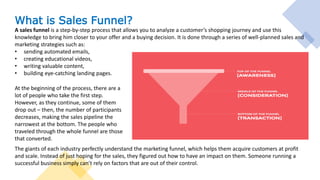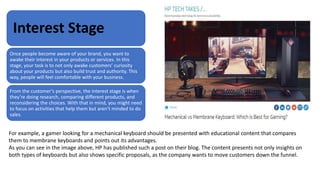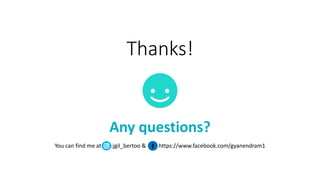Sales funnel
- 1. Presented by: Gyanendra Munda Corporate ID: 21AW21167 SALES FUNNEL
- 2. What is Sales Funnel? A sales funnel is a step-by-step process that allows you to analyze a customer’s shopping journey and use this knowledge to bring him closer to your offer and a buying decision. It is done through a series of well-planned sales and marketing strategies such as: • sending automated emails, • creating educational videos, • writing valuable content, • building eye-catching landing pages. At the beginning of the process, there are a lot of people who take the first step. However, as they continue, some of them drop out – then, the number of participants decreases, making the sales pipeline the narrowest at the bottom. The people who traveled through the whole funnel are those that converted. The giants of each industry perfectly understand the marketing funnel, which helps them acquire customers at profit and scale. Instead of just hoping for the sales, they figured out how to have an impact on them. Someone running a successful business simply can’t rely on factors that are out of their control.
- 3. WHY IS A SALES FUNNEL IMPORTANT? • Every business needs a constant flow of leads and customers – with a well-designed sales funnel, you know how to target customers at every stage of their customers’ journey. • Turning prospects into real customers – high website traffic has no real value if your conversion rate remains the same. • Getting loyal customers – sales funnel helps your marketing team understand which products your customers are interested in. That way, your team knows what recommendations would inspire your clients to repurchase. • Consistent and predictable revenue – with performance analysis, you will be able to measure how your marketing channels are performing on a daily, weekly, and monthly basis. • Finding drawbacks of your business – understanding each stage of the funnel can help you find the holes in your business system, that is the places where prospects drop out and never convert.
- 4. 4 Components of a Sales Funnel Awareness Interest The potential customer is actively seeking solutions to his or her problem(s). The potential customers finds you and takes an interest by signing up for your lead magnet or follows you on social media. The potential customer learns of your solutions for his or her problem; hears of your offer, product, sales or services. The potential customer makes a purchase with you. The potential customer likes your products, services, and solution and has decided to move forward with your offer. Decision Action
- 6. For example, a gamer looking for a mechanical keyboard should be presented with educational content that compares them to membrane keyboards and points out its advantages. As you can see in the image above, HP has published such a post on their blog. The content presents not only insights on both types of keyboards but also shows specific proposals, as the company wants to move customers down the funnel. Interest Stage Once people become aware of your brand, you want to awake their interest in your products or services. In this stage, your task is to not only awake customers’ curiosity about your products but also build trust and authority. This way, people will feel comfortable with your business. From the customer’s perspective, the interest stage is when they’re doing research, comparing different products, and reconsidering the choices. With that in mind, you might need to focus on activities that help them but aren’t minded to do sales.
- 7. Wrapping up, the interest stage is where you should educate your prospects on how they can solve their problems and achieve their goals. During that time, you can start building the demand for your products and services to get leads. That can be done by subtly offering the so-called lead magnets – in the case of a gamer above, you might offer a free consultation regarding a keyboard choice. However, HP goes straightforward and includes a clear CTA. If the content turns out to be convincing, this may be what many people actually want. Decision Stage The decision-making stage is where your potential customer has already finished the research process and makes a decision based on the acquired knowledge. Your goal is to help them make a positive decision and finally become your client. At this stage, customers are paying more attention to what you offer
- 8. Action Stage • After your prospects have decided to purchase your product or service, it’s time to finalize the deal. • If the customer relationship goes far beyond the act of purchasing, it gives you a chance to acquire loyal customers and therefore increase conversion rates. • After the buying process is complete, focus on customer retention by expressing gratitude for the purchase, inviting them to share feedback, making your brand available for support, etc. The marketers call this next stage an upsell stage. Upsell Stage • The upsell stage is where your business can make more money by encouraging customers to buy other related products or services. • Even though it may seem pushy in terms of in-person sales, the problem doesn’t exist in eCommerce. What is more, eCommerce brands can have an insight into the data to better understand what items or services would be the most relevant to the customer. • While working on the upsell stage, it’s crucial to determine what other products or services your customers might be interested in.
- 9. What is a Marketing Funnel? Differences between Sales funnel and Marketing funnel Definition The sales funnel refers to a system that guides a prospective customer from the marketing stage to the conversion. On the other hand, the marketing funnel refers to the process of converting a lead or a prospective into a customer. Focus While the sales funnel focuses on making more product or services sales, the marketing funnel focuses more on brand recognition and image. Interest In short, the term marketing funnel describes the customer journey from the awareness stage – when the customers get to know about the brand – to the transaction stage, when a website visitor becomes a customer
- 10. WHAT are the processes and stages involved in making a sales ? • The 7-step sales process 1. Prospecting 2. Preparation 3. Approach 4. Presentation 5. Handling Objections 6. Closing 7. Follow-up
- 12. 1. Prospecting In this stage, you find potential customers and determine whether they have a need for your product or service—and whether they can afford what you offer. 2. Preparation At this point, you develop your sales presentation and tailor it to your potential client’s particular needs. 3. Approach In the approach stage, you make first contact with your client. Sometimes this is a face-to-face meeting, sometimes it’s over the phone. There are three common approach methods. • Premium approach: Presenting your potential client with a gift at the beginning of your interaction. • Question approach: Asking a question to get the prospect interested. • Product approach: Giving the prospect a sample or a free trial to review and evaluate your service. 4. Presentation In the presentation phase, you actively demonstrate how your product or service meets the needs of your potential customer.
- 13. 5. Handling objections This is where you listen to your prospect’s concerns and address them. Successfully handling objections and alleviating concerns separates good salespeople from bad and great from good.
- 14. 6. Closing In the closing stage, you get the decision from the client to move forward. Depending on your business, you might try one of these three closing techniques. • Alternative choice close: Assuming the sale and offering the prospect a choice, where both options close the sale—for example, “Will you be paying the whole fee up front or in installments?” or “Will that be cash or charge?”. • Extra inducement close: Offering something extra to get the prospect to close, such as a free month of service or a discount. • Standing room only close: Creating urgency by expressing that time is of the essence—for example, “The price will be going up after this month” or “We only have six spots left”. 7. Follow-up Once you have closed the sale, your job is not done. The follow-up stage keeps you in contact with customers you have closed, not only for potential repeat business but for referrals as well. And since retaining current customers is six to seven times less costly than acquiring new ones, maintaining relationships is key.
- 15. Thanks! Any questions? You can find me at :jgil_bertoo & https://www.facebook.com/gyanendram1














